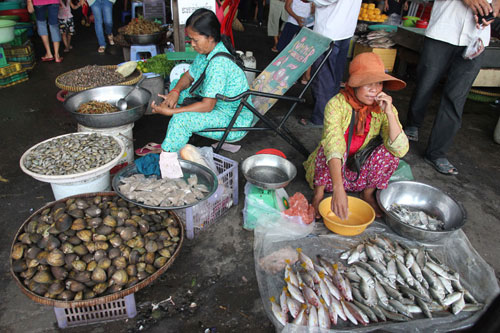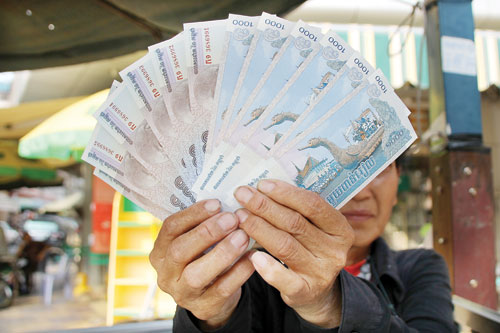Informal lending still thriving
Informal lending still thriving
The expanding banking sector and the spread of microfinance institutions (MFIs) in rural areas have failed to elbow informal, unlicensed money lending out of the market, industry experts say.

Fast and easy access to money – as well as the fear of “losing face” by borrowing in public – are contributing factors keeping the sector afloat, especially in rural areas.
“While there has been an increasing number of banks and MFIs, many farmers continue to rely on informal credit and the private money lender in their village,” said Vorn Pao, president of the Independent Democracy of Informal Economy Association, a group representing workers in informal sectors such as transportation.
The fact that such an organisation exists testifies to the economic relevance of an industry whose actual worth, due to a lack of recording, is hard to quantify.
Bun Mony, president of the Cambodia Microfinance Association (CMA), said informal lending was widespread before banks and microfinance institutions began sprouting up all over the country.
“So it became . . . the culture of Cambodian people.”
The culture, however, is slowly changing. With 238 branches, ACLEDA, Cambodia’s largest bank, now has a presence in every province.
Loan portfolios of the 35 registered MFIs and four NGOs that are members of the Cambodia Microfinance Association reached $1 billion at the end of the first quarter, a 41 per cent increase from the same period last year.
The figures also showed that deposits made at seven microfinance institutions that are licensed to take deposits reached $346 million, a 145 per cent increase between the end of March this year and the end of the first quarter last year.
But even with banks and microfinance giving informal lending a run for its money, five out of 10 Cambodian households that have at some stage borrowed money still access informal sources of credit, according to a study of rural and urban consumers conducted in June by Indochina Research.
“This confirms that informal lending still plays a significant role as an alternative access to funding in Cambodia,” Karl Johan Remoy, general manager of Indochina Research (Cambodia) Ltd, said. “However, as people are reluctant to talk about habits concerning usage of informal loans, we have to assume that the actual incidence is higher than what we are able to register in our survey.”
Others are attracted to the lack of red tape that is a feature of informal lending.
“Borrowers and money lenders know each other on a first name basis, residence, credit history, etc, and do not require borrowers to fill out application forms,” Kang Chandararot, director of the Cambodia Institute of Development Study, said.
Chandararot added that turning to private money lenders satisfies an impulse to “save face” and appear solvent.
For his part, Remoy has observed a cultural stigma attached to borrowing money when the lender comes from outside of the family.
The practice, as anyone who has ever borrowed money outside of a bank knows, is not without risks.
Informal loans can often surpass the monthly interest rates at microfinance institutions, and the temptation is to do the equivalent of using one credit card to pay off another.
“Farmers’ inability to make repayments to MFIs is a major reason that encourages people to borrow from informal moneylenders,” Pao, with the Independent Democracy of Informal Economy Association, said.
He said most people take an average of 1 million to 2 riel ($250 to $500) with an eye-popping interest rate of about 10 per cent per month, and find meeting payment deadlines onerous.
“Many have lost their cow, ox, or other property because of multiple loans from formal and informal lenders,” Pao said.
Mony, the Cambodia Microfinance Association president, said that, besides charging high interest rates, informal money lenders create unfair competition for the formal sector.
“We are not happy with the existence of the informal money lending sector,” he said. “Because this is unfair competition . . . with regulated institutions, you pay all the fees, all the tax. But [informal] money lending, they pay none. So they get only profit for themselves.”
According to Mony, microfinance institutions try to expand services and reach people, but in some areas, access to formal financial services is still missing.
He suggests undermining the industry by implementing a law that prevents the courts from accepting lawsuits filed by informal money lenders against borrowers.
But making such a move wades into the uncertain territory of categorising informal lending and applying rules to regulate its practice.
“When you borrow some money from someone in a bilateral agreement without a notary or without anything, it is just based on the trust between the two people and if anything happens, then it’s not under the central bank supervision,” National Bank of Cambodia director general Nguon Sokha said.
Chandararot from the Cambodia Institute of Development Study scoffs at the idea of going after the sector.
It poses “no risk to the economy and can make a financial system more flexible to demand,” he says. “Informal money lending is still filling a gap that formal institutions have not reached.”
“The rate of uncertainties is Cambodia is too high, such as unemployment, market risk, price risk. Therefore, people still need a financial source that can quickly help them out when they encounter such shocks.”
phnompenh post














